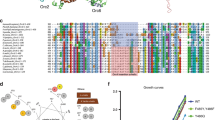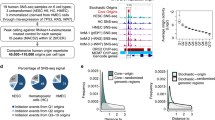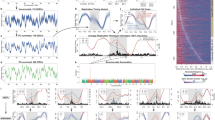Abstract
Site-specific initiation of DNA replication is a conserved function in all organisms. In Escherichia coli and Saccharomyces cerevisiae, DNA replication origins are sequence specific, but in multicellular organisms, origins are not so clearly defined. In this article, I present a model of origin specification by epigenetic mechanisms that allows the establishment of stable chromatin domains, which are characterized by autonomous replication. According to this model, origins of DNA replication help to establish domains of gene expression for the generation of cell diversity.
This is a preview of subscription content, access via your institution
Access options
Subscribe to this journal
Receive 12 print issues and online access
$209.00 per year
only $17.42 per issue
Buy this article
- Purchase on SpringerLink
- Instant access to full article PDF
Prices may be subject to local taxes which are calculated during checkout



Similar content being viewed by others
References
Jacob, F., Brenner, J. & Cuzin, F. On the regulation of DNA replication in bacteria. Cold Spring Harb. Symp. Quant. Biol. 28, 329–348 (1963).
Kornberg, A. & Baker, T. A. DNA Replication (Freeman, W. H. and Co., New York, 1992).
Challberg, M. D. & Kelly, T. J. Animal virus DNA replication. Annu. Rev. Biochem. 58, 671–717 (1989).
Dutta, A. & Bell, S. P. Initiation of DNA replication in eukaryotic cells. Annu. Rev. Cell Dev. Biol. 13, 293–332 (1997).
DePamphilis, M. L. Replication origins in metazoan chromosomes: fact or fiction? Bioessays 21, 5–16 (1999).
Berezney, R., Dubey, D. D. & Huberman, J. A. Heterogeneity of eukaryotic replicons, replicon clusters, and replication foci. Chromosoma 108, 471–484 (2000).
Newlon, C. S. & Theis, J. F. The structure and function of yeast ARS elements. Curr. Opin. Genet. Dev. 3, 752–758 (1993).
Kelly, T. J. & Brown, G. M. Regulation of chromosome replication. Annu. Rev. Biochem. 69, 829–880 (2000).
Harland, R. M. & Laskey, R. A. Regulated replication of DNA microinjected into eggs of Xenopus laevis. Cell 21, 761–771 (1980).
Méchali, M. & Kearsey, S. Lack of specific sequence requirement for DNA replication in Xenopus eggs compared with high sequence specificity in yeast. Cell 38, 55–64 (1984).
Wolffe, A. P. Chromatin: Structure and Function (Academic Press, San Diego, California, 1998).
Linskens, M. & Huberman, J. A. Organization of replication in ribosomal DNA in Saccharomyces cerevisiae. Mol. Cell. Biol. 8, 4927–4935 (1988).
Friedman, K. L., Brewer, B. J. & Fangman, W. L. Replication profile of Saccharomyces cerevisiae chromosome VI. Genes Cells 2, 667–678 (1997).
Theis, J. F. & Newlon, C. S. Two compound replication origins in Saccharomyces cerevisiae contain redundant origin recognition complex binding sites. Mol. Cell. Biol. 21, 2790–2801 (2001).
Bell, S. P. & Stillman, B. ATP-dependent recognition of eukaryotic origins of DNA replication by a multiprotein complex. Nature 357, 128–134 (1992).
Abdurashidova, G. et al. Start sites of bidirectional DNA synthesis at the human lamin B2 origin. Science 287, 2023–2026 (2000).
Todorovic, V., Falaschi, A. & Giacca, M. Replication origins of mammalian chromosomes: the happy few. Front. Biosci. 4, D859–D868 (1999).
Tjian, R. & Maniatis, T. Transcriptional activation: a complex puzzle with few easy pieces. Cell 77, 5–8 (1994).
Aladjem, M. I., Rodewald, L. W., Kolman, J. L. & Wahl, G. M. Genetic dissection of a mammalian replicator in the human β-globin locus. Science 281, 1005–1009 (1998).
Altman, A. L. & Fanning, E. The Chinese hamster dihydrofolate reductase replication origin β is active at multiple ectopic chromosomal locations and requires specific DNA sequence elements for activity. Mol. Cell. Biol. 21, 1098–1110 (2001).
Kitsberg, D., Selig, S., Keshet, I. & Cedar, H. Replication structure of the human β-globin gene domain. Nature 366, 588–590 (1993).
Malott, M. & Leffak, M. Activity of the c-myc replicator at an ectopic chromosomal location. Mol. Cell. Biol. 19, 5685–5695 (1999).
Brewer, B. J. & Fangman, W. L. Initiation preference at a yeast origin of replication. Proc. Natl Acad. Sci. USA 91, 3418–3422 (1994).
Gomez, M. & Antequera, F. Organization of DNA replication origins in the fission yeast genome. EMBO J. 18, 5683–5690 (1999).
Haber, J. E. Mating-type gene switching in Saccharomyces cerevisiae. Annu. Rev. Genet. 32, 561–599 (1998).
Foss, M., McNally, F. J., Laurenson, P. & Rine, J. Origin recognition complex (ORC) in transcriptional silencing and DNA replication in S. cerevisiae. Science 262, 1838–1844 (1993).
Micklem, G., Rowley, A., Harwood, J., Nasmyth, K. & Diffley, J. F. Yeast origin recognition complex is involved in DNA replication and transcriptional silencing. Nature 366, 87–89 (1993).
Bell, S. P., Kobayashi, R. & Stillman, B. Yeast origin recognition complex functions in transcription silencing and DNA replication. Science 262, 1844–1849 (1993).
Triolo, T. & Sternglanz, R. Role of interactions between the origin recognition complex and SIR1 in transcriptional silencing. Nature 381, 251–253 (1996).
Bell, S. P., Mitchell, J., Leber, J., Kobayashi, R. & Stillman, B. The multidomain structure of Orc1p reveals similarity to regulators of DNA replication and transcriptional silencing. Cell 83, 563–568 (1995).
Fox, C. A., Ehrenhofer-Murray, A. E., Loo, S. & Rine, J. The origin recognition complex, SIR1, and the S phase requirement for silencing. Science 276, 1547–1551 (1997).
Gavin, K. A., Hidaka, M. & Stillman, B. Conserved initiator proteins in eukaryotes. Science 270, 1667–1671 (1995).
Ehrenhofer-Murray, A. E., Gossen, M., Pak, D. T., Botchan, M. R. & Rine, J. Separation of origin recognition complex functions by cross-species complementation. Science 270, 1671–1674 (1995).
Pak, D. T. et al. Association of the origin recognition complex with heterochromatin and HP1 in higher eukaryotes. Cell 91, 311–323 (1997).
Huang, D. W. et al. Distinct cytoplasmic and nuclear fractions of Drosophila heterochromatin protein 1: their phosphorylation levels and associations with origin recognition complex proteins. J. Cell Biol. 142, 307–318 (1998).
Chuang, R. Y. & Kelly, T. J. The fission yeast homologue of Orc4p binds to replication origin DNA via multiple AT-hooks. Proc. Natl Acad. Sci. USA 96, 2656–2661 (1999).
Iizuka, M. & Stillman, B. Histone acetyltransferase HBO1 interacts with the ORC1 subunit of the human initiator protein. J. Biol. Chem. 274, 23027–23034 (1999).
Ermakova, O. V. et al. Evidence that a single replication fork proceeds from early to late replicating domains in the IgH locus in a non-B cell line. Mol. Cell 3, 321–330 (1999).
Dijkwel, P. A. & Hamlin, J. L. The Chinese hamster dihydrofolate reductase origin consists of multiple potential nascent-strand start sites. Mol. Cell. Biol. 15, 3023–3031 (1995).
Kobayashi, T., Rein, T. & DePamphilis, M. L. Identification of primary initiation sites for DNA replication in the hamster dihydrofolate reductase gene initiation zone. Mol. Cell. Biol. 18, 3266–3277 (1998).
Kalejta, R. F. et al. Distal sequences, but not ori-beta/OBR-1, are essential for initiation of DNA replication in the Chinese hamster DHFR origin. Mol. Cell 2, 797–806 (1998).
Thoma, F., Bergman, L. W. & Simpson, R. T. Nuclease digestion of circular TRP1ARS1 chromatin reveals positioned nucleosomes separated by nuclease-sensitive regions. J. Mol. Biol. 177, 715–733 (1984).
Lipford, J. R. & Bell, S. P. Nucleosomes positioned by ORC facilitate the initiation of DNA replication. Mol. Cell 7, 21–30 (2001).
Minc, E., Courvalin, J. C. & Buendia, B. HP1γ associates with euchromatin and heterochromatin in mammalian nuclei and chromosomes. Cytogenet. Cell Genet. 90, 279–284 (2000).
Eissenberg, J. C. & Elgin, S. C. The HP1 protein family: getting a grip on chromatin. Curr. Opin. Genet. Dev. 10, 204–210 (2000).
Pirrotta, V. Polycombing the genome: PcG, trxG, and chromatin silencing. Cell 93, 333–336 (1998).
Cavalli, G. & Paro, R. Chromo-domain proteins: linking chromatin structure to epigenetic regulation. Curr. Opin. Cell Biol. 10, 354–360 (1998).
Nicolas, R. H. & Goodwin, G. H. Molecular cloning of polybromo, a nuclear protein containing multiple domains including five bromodomains, a truncated HMG-box, and two repeats of a novel domain. Gene 175, 233–240 (1996).
Callebaut, I., Courvalin, J. C. & Mornon, J. P. The BAH (bromo-adjacent homology) domain: a link between DNA methylation, replication and transcriptional regulation. FEBS Lett. 446, 189–193 (1999).
Henderson, D. S., Banga, S. S., Grigliatti, T. A. & Boyd, J. B. Mutagen sensitivity and suppression of position-effect variegation result from mutations in mus209, the Drosophila gene encoding PCNA. EMBO J. 13, 1450–1459 (1994).
Shibahara, K. & Stillman, B. Replication-dependent marking of DNA by PCNA facilitates CAF-1-coupled inheritance of chromatin. Cell 96, 575–585 (1999).
Zhang, Z., Shibahara, K. & Stillman, B. PCNA connects DNA replication to epigenetic inheritance in yeast. Nature 408, 221–225 (2000).
Murzina, N., Verreault, A., Laue, E. & Stillman, B. Heterochromatin dynamics in mouse cells: interaction between chromatin assembly factor 1 and HP1 proteins. Mol. Cell 4, 529–540 (1999).
Diffley, J. F. Once and only once upon a time: specifying and regulating origins of DNA replication in eukaryotic cells. Genes Dev. 10, 2819–2830 (1996).
Lu, L., & Tower, J. A transcriptional insulator element, the su(Hw) binding site, protects a chromosomal DNA replication origin from position effects. Mol. Cell Biol. 17, 2202–2206 (1997).
Wang, S., Dijkwel, P. A. & Hamlin, J. L. Lagging-strand, early-labelling, and two-dimensional gel assays suggest multiple potential initiation sites in the Chinese hamster dihydrofolate reductase origin. Mol. Cell. Biol. 18, 39–50 (1998).
Van der Vliet, P. C. in DNA Replication in Eukaryotic Cells (ed. DePamphilis, M. C.) (Cold Spring Harbor Laboratory Press, New York, 1996).
Cheng, L. & Kelly, T. J. Transcriptional activator nuclear factor I stimulates the replication of SV40 minichromosomes in vivo and in vitro. Cell 59, 541–551 (1989).
Wei, X. et al. Segregation of transcription and replication sites into higher order domains. Science 281, 1502–1506 (1998).
Brewer, B. J. When polymerases collide: replication and the transcriptional organization of the E. coli chromosome. Cell 53, 679–686 (1988).
Snyder, M., Sapolsky, R. J. & Davis, R. W. Transcription interferes with elements important for chromosome maintenance in Saccharomyces cerevisiae. Mol. Cell. Biol. 8, 2184–2194 (1988).
Haase, S. B., Heinzel, S. S. & Calos, M. P. Transcription inhibits the replication of autonomously replicating plasmids in human cells. Mol. Cell. Biol. 14, 2516–2524 (1994).
Deshpande, A. M. & Newlon, C. S. DNA replication fork pause sites dependent on transcription. Science 272, 1030–1033 (1996).
Muller, M., Lucchini, R. & Sogo, J. M. Replication of yeast rDNA initiates downstream of transcriptionally active genes. Mol. Cell 5, 767–777 (2000).
Callan, H. G. Replication of DNA in the chromosomes of eukaryotes. Proc. R. Soc. Lond. B 181, 19–41 (1972).
Blumenthal, A. B., Kriegstein, H. J. & Hogness, D. S. The units of DNA replication in Drosophila melanogaster chromosomes. Cold Spring Harb. Symp. Quant. Biol. 38, 205–223 (1974).
Hyrien, O. & Méchali, M. Chromosomal replication initiates and terminates at random sequences but at regular intervals in the ribosomal DNA of Xenopus early embryos. EMBO J. 12, 4511–4520 (1993).
Hyrien, O., Maric, C. & Méchali, M. Transition in specification of embryonic metazoan DNA replication origins. Science 270, 994–997 (1995).
Sasaki, T., Sawado, T., Yamaguchi, M. & Shinomiya, T. Specification of regions of DNA replication initiation during embryogenesis in the 65-kilobase DNApolα-dE2F locus of Drosophila melanogaster. Mol. Cell. Biol. 19, 547–555 (1999).
Vassetzky, Y., Hair, A. & Méchali, M. Rearrangement of chromatin domains during development in Xenopus. Genes Dev. 14, 1541–1552 (2000).
Gurdon, J. B. Genetic reprogramming following nuclear transplantation in amphibia. Semin. Cell Dev. Biol. 10, 239–243 (1999).
Kitsberg, D. et al. Allele-specific replication timing of imprinted gene regions. Nature 364, 459–463 (1993).
Aladjem, M. I. et al. Participation of the human β-globin locus control region in initiation of DNA replication. Science 270, 815–819 (1995).
Cimbora, D. M. et al. Long-distance control of origin choice and replication timing in the human β-globin locus are independent of the locus control region. Mol. Cell. Biol. 20, 5581–5591 (2000).
Acknowledgements
I wish to thank D. Fisher, D. Maiorano and P. Françon for helpful comments on this manuscript. Work in our laboratory is mainly supported by the CNRS, ARC and FRM.
Author information
Authors and Affiliations
Glossary
- (A+T)-HOOK MOTIF
-
A nine-amino-acid protein domain that binds to the minor groove of (A+T)-rich DNA.
- BOUNDARY ELEMENT
-
A DNA element that lies between two gene-controlling elements, such as a promoter and enhancer, preventing their communication or interaction. The function of boundary elements is usually mediated by the binding of specific factors.
- BROMO-ADJACENT-HOMOLOGY DOMAIN
-
A domain of unknown function that is found in several proteins that are involved in chromatin remodelling and epigenetic mechanisms.
- CHROMODOMAIN
-
A protein motif that is involved in binding certain methylated histones; often associated with transcriptional repression.
- HETEROCHROMATIN
-
The densely staining regions of the nucleus that generally contain condensed, transcriptionally inactive regions of the genome.
- HIGH MOBILITY GROUP PROTEINS
-
Non-histone proteins involved in chromatin structure and gene regulation.
- INSULATOR ELEMENT
-
A chromatin element that acts as a barrier against the influence of positive (enhancers) or negative (silencers) signals.
- ORIGIN RECOGNITION COMPLEX
-
A complex of six subunits that binds to the origins of DNA replication in an ATP-dependent manner.
- POLYCOMB-GROUP PROTEINS
-
Genes that are involved in the heritable repression of developmentally regulated genes, such as the homeotic genes.
- POSITION-EFFECT VARIEGATION
-
A phenomenon discovered in Drosophila, which occurs when genes placed close to large heterochromatic regions are repressed. This repression is metastable, in that the silenced state can be occasionally released, giving rise to derepressed cells and a variegated phenotype.
- REPLICON
-
A genetic element that contains a single origin of DNA replication, recognized by a specific positive regulatory protein or complex.
Rights and permissions
About this article
Cite this article
Méchali, M. DNA replication origins: from sequence specificity to epigenetics. Nat Rev Genet 2, 640–645 (2001). https://doi.org/10.1038/35084598
Issue Date:
DOI: https://doi.org/10.1038/35084598



